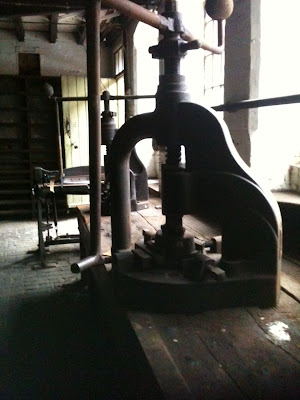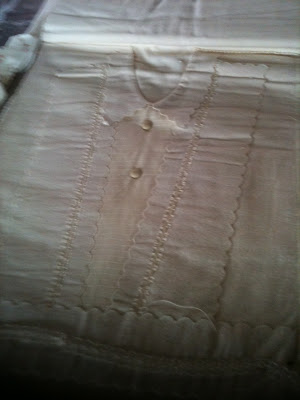A VISIT TO
THE VICTORIAN COFFIN FURNITURE FACTORY
In a subtle, creeping moment I realized that my life was not
normal. No other child in my class slept above a room full of caskets. To
descend the stairs in our house meant discovering who might be lying in one of
those open caskets, a reposed, powdered face ready for viewing. No child I knew
looked forward to a visit to the cemetery, or was subjected to sitting in long
stretches of silence while a funeral service droned on downstairs, the organ
music signalling The End notes.
Since then I have sought the unusual without much thought
that the draw emanated from that languid funeral home, a dot on the map of the
American South. I could never foresee that once I left my father’s house of
death, I would one day stand in a remarkable historic coffin fittings
factory in Birmingham, England.
When I first read of the existence of the Newman Brothers
Coffin Furniture Factory I experienced a mighty magnetic pull to discover what
was sure to be a treasure. When I realized the goal of the talented people at
the Birmingham Conservation Trust, I felt a strong urge to shout:
LISTEN UP! THERE ARE EXTRAORDINARY PLANS UNDERWAY TO CREATE
BRITAIN’S FIRST FUNEREAL MUSEUM.
In 1894 raw materials arrived via the Birmingham Fazeley
Canal to the yard doors of 13-15 Fleet Street, a short street then full of
manufacturers. Today, Newman Brothers is the last to stand, the only complete
historic building left, gloriously sandwiched between the towering jagged
modern buildings that now dominate the street.
Its almost hidden position faces east where light streams
into the small paned cast iron windows of the three-story Victorian building
and into the windows of the rebuilt 1960s two-story building.
This was the setting where for over one hundred years
artisan funereal work was accomplished to such a high standard that the coffin
fittings produced here, from raw material to finished product, were world
famous and seen on the coffins of Churchill, the Queen Mother and Princess
Diana.
Winston Churchill's coffin is lowered into the grave at
Bladon Graveyard
In an atmosphere where everyone felt part of a family, and
wherein a large number of females were employed, like Diamond Lil who read
teacups, and Dolly who was a little deaf, employees are well remembered in
photographs and in the palpable oral history arm of the project. Polishers,
stampers, and piercers are brought to life through interviews and the products
they created in the Grade II listed building.
Stamp Room
Though Newman Brothers had plans to begin manufacturing
coffins, the plans never came to fruition; however, from the mid twentieth
century they began manufacturing burial shrouds and coffin linings.
When the factory was sold in 2003 everything was left in
situ, as if the entire company had just stepped out to lunch. Thousands of
artefacts littered the rooms. Along with stock, manufacturing tools and
equipment, items of poignancy were startling. Overalls hung on a hook. A
woman’s handbag was left behind. Tea making accoutrement stood at the ready,
and the tongs for making toast hung by the fireside.
The Newman Brothers travelling salesman's bag, fully stocked.
Imagine Mr. Allen on his Triumph motorbike, his samples bags
filled with breast plates, coffin handles, crucifixes, catalogues and shroud
material, all tucked away in the wickerwork sidecar and headed all over England
and Ireland where his was the first motorbike to travel many of its roads.
When I was a child I often watched my father polish the
handles of one of his many caskets. Not that they needed this extra care; the
casket and its fittings arrived in perfect condition. Could any of them have
possibly originated from Newman Brothers?
And how many ways might one use a casket handle? They make a
nice paperweight, or door handle…
The plans for the museum are terrifically ambitious. The use
of film, sound, an iBook interactive element, special hands on activities for
children, object interpretation, to name only a few mediums, will contribute to
create one of the premier examples of how a Victorian factory actually worked,
while simultaneously showing the changes in the business of death and funerary
rituals from the Victorian era to the present.
The renovation has begun and next year 13-15 Fleet Street
will be home to its own unique jewel in The Jewellery Quarter of Birmingham.
Many thanks to my guide, the brilliantly informed volunteer
Barbara Nomikos who deftly lead me room by room, step by step through the
fascinating pre-renovated world of funeral furniture manufacturing. Grateful
thanks also to Suzanne Carter of the Birmingham Conservation Trust for
permissions and introductions.

















Oh, that would be so wonderful to see. If you are ever in Houston, TX, we have a funeral museum here that is very interesting.
ReplyDeleteYes, I have heard about the museum in Texas. Would be great to see it.
ReplyDeleteThank you very much for reading.
Utterly fascinating!
ReplyDeleteThank you Madame Gilflurt! It really is, and I can't wait to go back.
Delete